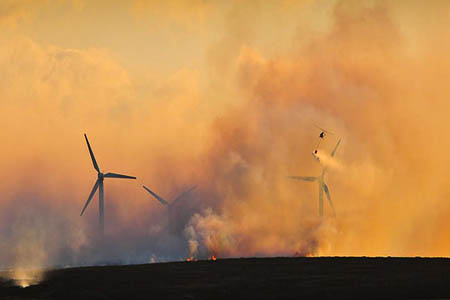Walkers and outdoor enthusiasts are being warned the fire risk on Pennine moors is high as Easter approaches.
And a firefighter said the fire service now recognised moorlands were ‘as valuable as bricks and mortar’, after the setting up of a special group to tackle the problem of wildfires in inaccessible areas.
A spokesperson for Pennine Prospects, a regeneration organisation for the rural areas in the moorlands between the Peak District and the Yorkshire Dales, said: “Despite the winter rain, early spring is a real danger period for moorland wildfires.
“The peat dries out and as more people venture into the South Pennines landscape for recreation, wildfires are more likely to happen. Between 1 October and 15 April some controlled burning by landowners takes place, but a fire started outside of these dates is a wildfire and any person caught starting one can be prosecuted for arson.”
Pennine Prospects has set up the South Pennines Fire Operations Group, a partnership of the three fire services in Greater Manchester, Lancashire and West Yorkshire; the area’s water companies Yorkshire Water and United Utilities, as well as private estates; the six South Pennines local authorities and Natural England.
FOG’s chair Danny Jackson said: “The negative impact of wildfires across the moors is now being recognised.
“The loss of habitat and the effect that these fires have on nesting birds, such as the endangered twite, can clearly be seen but we also want to highlight the hidden dangers: the pollution, the release of carbon into the atmosphere, and the impact on people’s health. In the weeks following last year’s moorland fires there were reports of increased visits to the doctors because of smoke inhalation.”
Robin Ward, wildfire officer for the West Yorkshire Fire and Rescue Service, said: “Please be very careful when you are out on the moors. Dispose of any glass bottles and cigarettes in a responsible manner and remember to use your barbecue at home rather than on the moors.
“If you see a wildfire please report it through the 999 service giving its location as precisely as possible. And we would also ask people to report anyone acting suspiciously.
“Until recently moorland fires were seen as a low priority but now the uplands are recognised as being as valuable as bricks and mortar.
“If the peat burns it can be very difficult to extinguish and these fast moving fires in off-road locations can be tiring for firefighting crews and resource intensive, which means that we may be stretched if fires occur elsewhere.”
He added: “Through the FOG partnership landowners can see how the fire services operate and how they can assist when dealing with a wildfire.
“They know the areas well and have their own specialist equipment, such as all-terrain vehicles, as well as additional human resources to tackle fires. We are firefighting together.”
The cross-boundary nature of the South Pennines causes difficulties as fire crews from one area do not necessarily know all the terrain. Charlie Yorke, representative of private landowners, explained: “These are huge moorland areas, all off-road, and if there’s a fire the landowners are best placed to know the best way to approach it.
“Through FOG we are working on creating plans of the area: who owns what, who has the shooting rights and who are the people to contact. We are working well together.”
Fires during their breeding season can have a devastating impact said Charlotte Weightman, the Royal Society for the Protection of Birds’ habitat intervention officer for the twite recovery project. “In England the twite only breeds in the South Pennines and there are only about 100 breeding pairs in approximately 20 colonies so it’s crucial that they are not disturbed. Unfortunately last year four colonies were disturbed by wildfires,” she said.
The negative impact of wildfires even damages the important archaeology of the South Pennines, including Bronze Age carved rocks, added Edie Jolley, Pennine Prospects FOG fire plans coordinator.
The South Pennines form part of the Pennine range, lying between the Peak District and Yorkshire Dales national parks. The landscape contains sweeping moorlands, pastures enclosed by dry stone walls and gritstone settlements contained in narrow valleys. The moorlands support rare species of bird such as merlin, short-eared owl and twite.
- Many other areas in Britain are at risk of wildfires following the drier than usual spring and unseasonable high temperatures last week. Northumberland National Park Authority Tweeted to grough: “Please mention to readers dry conditions in NNP and take care. Some small wildfires, under control, in last week.”
